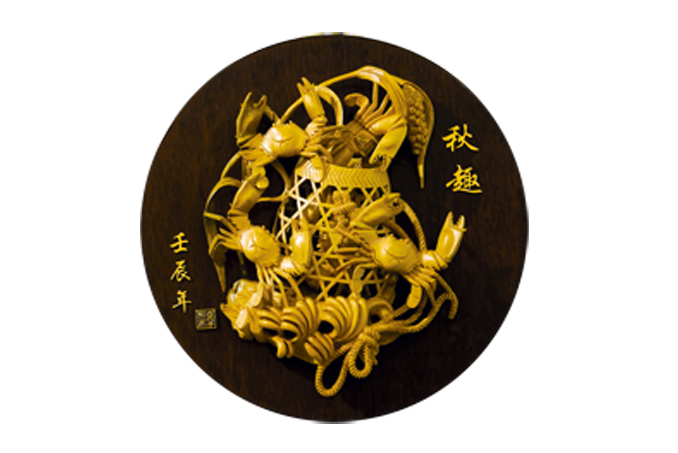Written by: Hang Jiang
Posted on: November 12, 2013 |  | 中文
| 中文
Woodcarving in China constitutes three major categories: architecture carving, furniture carving and artworks carving.
Woodcarving as handiworks for display or fondling started from the Song Dynasty (960—1279 AD) when the practice of fondling artworks gradually rose among men of letters and scholars. This prevailing custom reached its primary stage in the Ming and Qing dynasties. Furnishing artworks are a traditional category in wood carving, which are placed on cabinets, windowsills, tables, shelves, etc. Wood carving can also be used to decorate all sorts of furniture and other artworks such as jade ware, cloisonné and chinaware.
Woodcarving can be seen all over the region on both sides of the Yangtze River where the best known includes the Dongyang woodcarving in Zhejiang Province, the golden-lacquer woodcarving in Guangdong Province, Longan woodcarving in Fujian Province and Huizhou woodcarving in Anhui Province.
The Dongyang County of Zhejiang Province has always been celebrated for being the "home of carving arts." Dongyang woodcarving started from the Tang Dynasty, developed in the Song Dynasty and became popular in the Ming and Qing dynasties. Dongyang carvings preserve the original textures and colors of the wood which, when meticulously polished, makes the finished works appear smooth and lustrous. Relief carving is the essence of Dongyang woodcarving in which the depth of the patterns ranges between two and five millimeters. The centerpiece is focused on by the force of the cutting. The designs of Dongyang woodcarving stress on "carving all over the background," which means to have patterns carved over the entire surface of the object so that it has three dimensional display while the background is fully covered. This is a unique artistic style.
 |
Gold lacquer woodcarving is a specialty of the Chaozhou region in Guangdong Province, also known as Chaozhou woodcarving, so named because of the gold coating on the surface. Gold lacquer woodcarving at first was a decorative art used in architecture in ancient China. Later on it was influenced by local art and became a school of woodcarving featuring local flavor. In Chaozhou, local people have especially compounded a kind of lacquer which not only enables the gold foil to adhere to the surface of the wood, but also makes it moisture-proof and rot-proof. The history of Chaozhou woodcarving can be traced back to the Tang Dynasty, or even earlier times. The Qing Dynasty was the heyday of its development when the fretwork developed from single-layer to multi-layer piercing, thus producing an artistic effect of a strong contrast between far and near, large and small.
Fujian Longan (Euphoria Longan, evergreen tree) carving developed from furniture decoration and statue-of-Buddha carving, matured at the end of Ming Dynasty and the beginning of the Qing Dynasty. Longan is slightly brittle in texture, fine grained, reddish brown in color, mainly growing in the southern area of Fujian Province. The trunk, in particular the roots of old-age Longan, often grow to be either spectacular or grotesque in form, which is an ideal wood piece for engraving. Root carving therefore becomes the unique variety of Fuzhou woodcarving. Local artisans, making the best use of its natural shape, by chopping with axe or cutting with chisel, have the twisted roots with their rough nodes carved into all sorts of figures, such as birds and beasts, in shapes that are vivid and artistically exaggerated. Fuzhou woodcarving, when smoothed and polished, can reveal an unsophisticated brass yellow or orange color that will never fade.
Wood used in Huizhou woodcarving includes softer tree species such as pine, China fir, camphor tree, nanmu, (a kind of Phoebe), gingko, etc. What Huizhou woodcarving stresses is not the quality of wood, but the content of subject matters, the skills at carving, and the perfection of the composition and lines, which has exerted a great influence on the surrounding areas. In the Ming and Qing dynasties, Huizhou woodcarving focused on architecture and furniture decoration, well-known for its giant-sized carved paintings whose themes are mostly "men farming and women weaving," fishing, woodcutting, plowing, studying, fairy tales, legends, historical stories, classic novels, and so on and so forth.
You may also like: